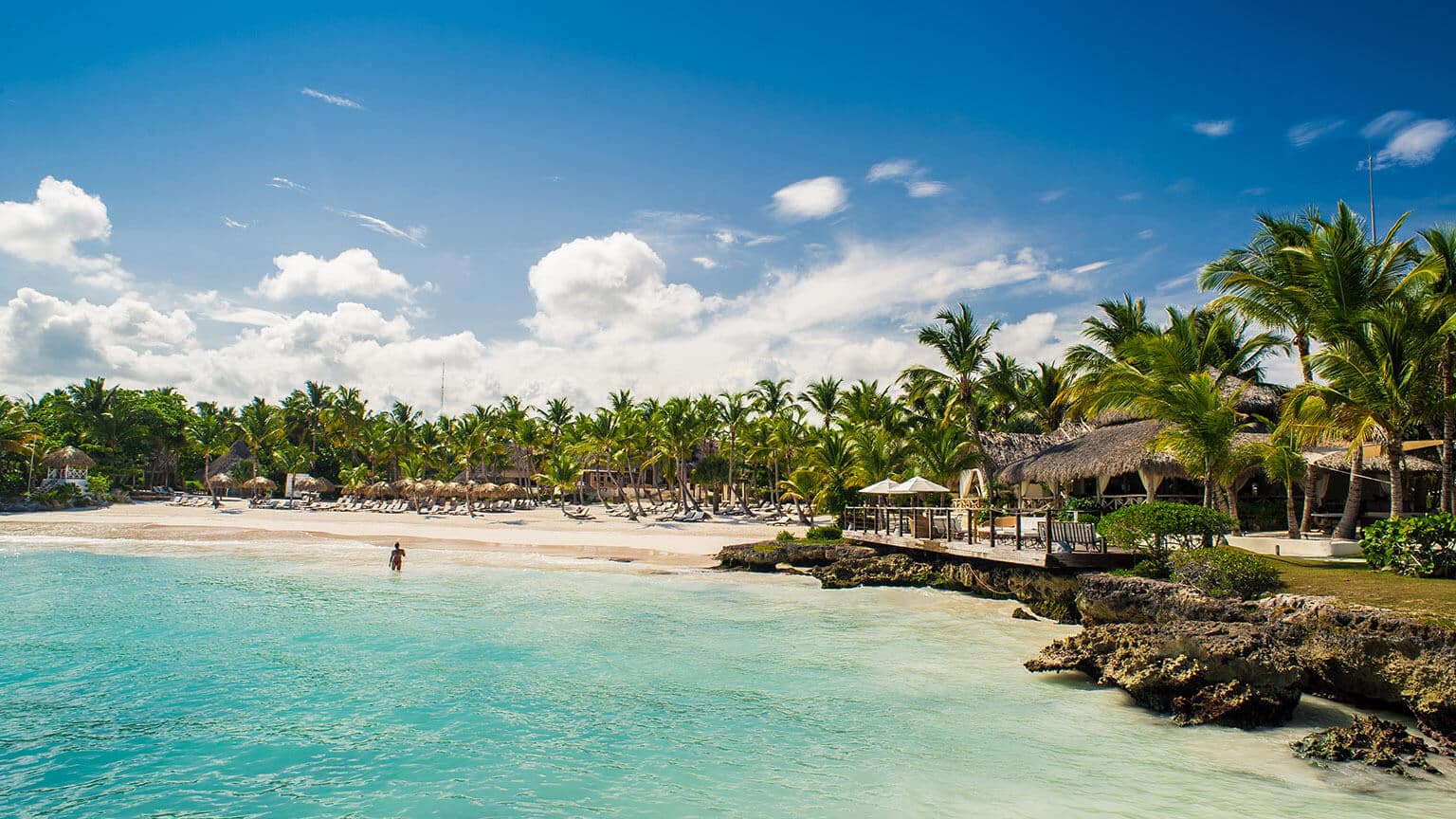

Summary
The pearl of the Caribbean Sea is the Mesoamerican Barrier Reef, which is under the protection of UNESCO. The endemic plants, coral reefs, and sunken pirate treasures attract naturalists, fishers, and divers worldwide.
The Caribbean Sea is one of the most beautiful places on the planet. Before the pandemic, about 30 million tourists visited the region every year, amounting to two-thirds of the Caribbean Islands' population.
Other facts
Where is the Caribbean Sea located
The Caribbean Sea is located in the west of the tropical zone of the Atlantic Ocean. In the south and west, the sea washes the coasts of Central and South America. It is bounded in the north and east by the Caribbean Islands.
Nine Caribbean countries are located on the mainland: Mexico, Belize, Guatemala, Honduras, Nicaragua, Costa Rica, Panama, Colombia and Venezuela. The other 26 states are on separate islands. The only exception is the island of Haiti, containing two countries: Haiti and the Dominican Republic.
Caribbean Islands and countries
There are about 700 islands, reefs and atolls in the Caribbean Sea. The Caribbean Islands include the Bahamas, as well as Greater and Lesser Antilles. They cover a total area of 244,890 km². This is comparable to the territory of Britain.
The exact number of islands cannot be calculated as some of them periodically sink under the sea, while others reappear from under the sea.
10 largest Caribbean islands
The Bahamas are formed by coral reefs. Cuba and the Virgin Islands are also surrounded by reefs. The reef islands have a relatively smooth coastline and sandy beaches.
The Lesser Antilles , such as St Lucia and Antigua and Barbuda,appeared as a result of a volcanic eruption. On volcanic islands, there are many stone beaches, cliffs, and a more indented coastline.
There are many mountains in the Lesser Antilles, the highest in northern Jamaica and eastern Cuba. The Jamaican Blue Mountain Peak reaches a height of 2,256 meters. Hiking trails are laid on all the mountains, even on volcanoes. Tourists can watch them erupt.
There are several large bays in the southwestern part of the Caribbean Sea: Honduras, Mosquito, Darien and Venezuela. The bays of Batabano, Ana Maria and Guacanayabo are located in the northern part of the sea in Cuba, and the Gulf of Gonave on the island of Haiti can be found in the western part of the sea. The beauty of each of them can be appreciated by taking a cruise in the Caribbean.
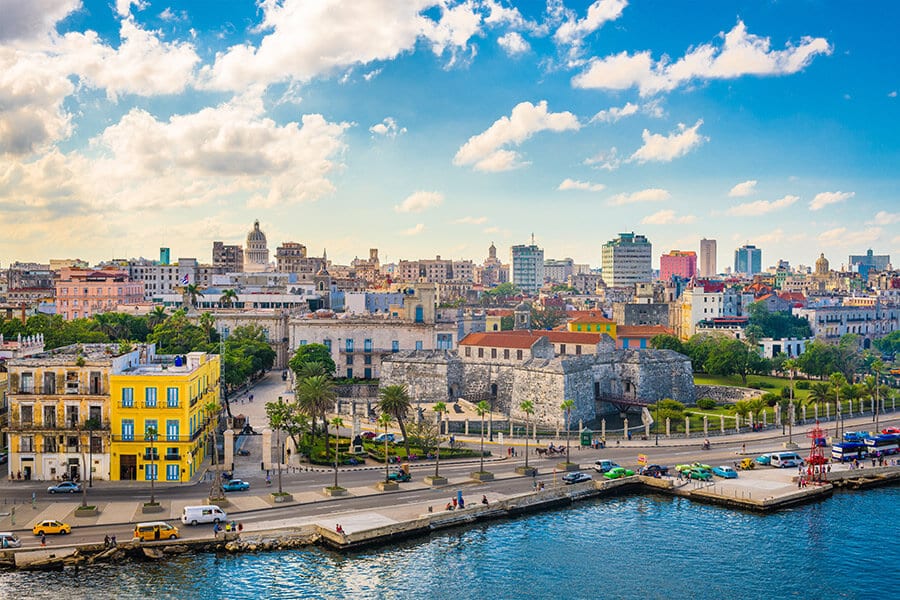
Cuba is comparable in area to Bulgaria. The country has a vibrant architecture of buildings in the colonial style: a mix of Gothic, neoclassical and baroque with Moorish motifs
Flora and fauna of the Caribbean Sea
Vegetation. In total, there are about 13,000 plant species in the region. Moreover, about half of them are unique and cannot be found anywhere else in the world.
Animals. About 450 species of fish live in the Caribbean Sea, including sharks, flying fish, rays and moray eels. 90 species represent mammals in the region: in the sea, you can find sperm whales, humpback whales, rays and dolphins. American manatees and seals live off the coast of Jamaica.
The Caribbean Sea is famous for its turtles: Christopher Columbus named one of the islands La Tortuga Island in their honour. These islands are now called the Cayman Islands.
About 500 species of reptiles live on the islands: rare cycluras, sharp-snouted crocodiles and various sea turtles. It is also believed that all amphibian species of the region are endemic; i.e., they live exclusively in the Caribbean Basin. Some families of toads, poison dart frogs, and tree frogs live on only one island.
There are 163 species of endemic birds found in the Caribbean Basin, such as the imperial amazon, the Cuban avocet woodpecker, and the palm swift. Parrots, sugarbirds and toucans are also found in the forests, while frigatebirds and Phaethon can be found above the open sea.
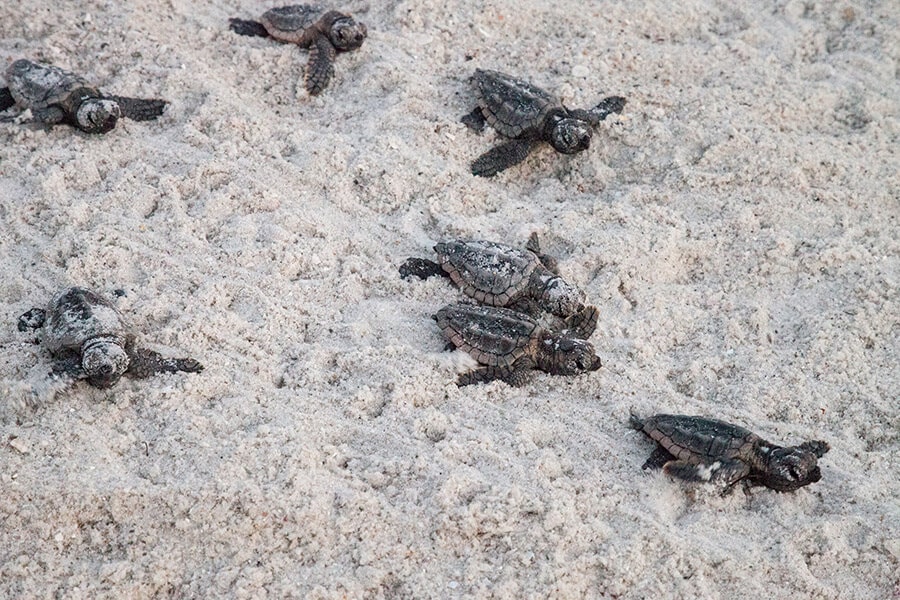
Loggerhead turtles make their way across the beach into the sea after hatching
Holidays on the Caribbean Sea
Visitors describe the Caribbean Sea resorts as paradise on Earth: white beaches, clear and warm water, exotic sea habitats teeming with wildlife, tropical greenery and almost constant sunshine. For instance, Cuba has up to 330 sunny days a year.
Readers of Condé Nast Traveler ranked the best islands in the Caribbean Basin and Atlantic for a holiday in 2021 as follows:
-
St Barts
-
Nevis
-
Anguilla
-
Jamaica
-
Antigua
-
Cayman Islands
-
Aruba, Bonaire and Curacao
-
Puerto Rico
-
St Lucia
-
US Virgin Islands
Most of the tourists in the Caribbean are from the United States, United Kingdom and Europe.
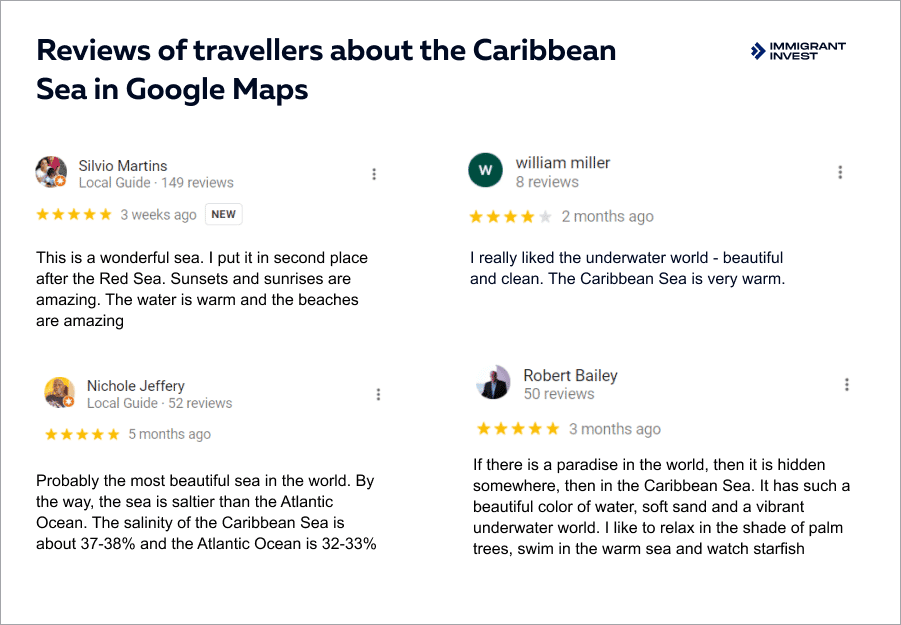
Fishing, snorkelling, diving and yachting in the Caribbean
Fishing. Fishers from all over the world come to the Caribbean to catch sailfish, swordfish, blue and white marlin, and barracuda.
Each country in the Caribbean has its own rules for fishing. For example, in St Lucia, amateur fishing licenses are issued only to its citizens and residents. It costs about $19 and is issued by the Department of Fisheries.
In the coastal waters of Antigua, tourists do not need a fishing license if they go to sea in a boat with a captain. As all fishing boats in Antigua must obtain a fishing license, tourists pay only for the boat trip.
In the Caribbean, there are professional competitions and tournaments for fishers, such as catching swordfish in Cuba.
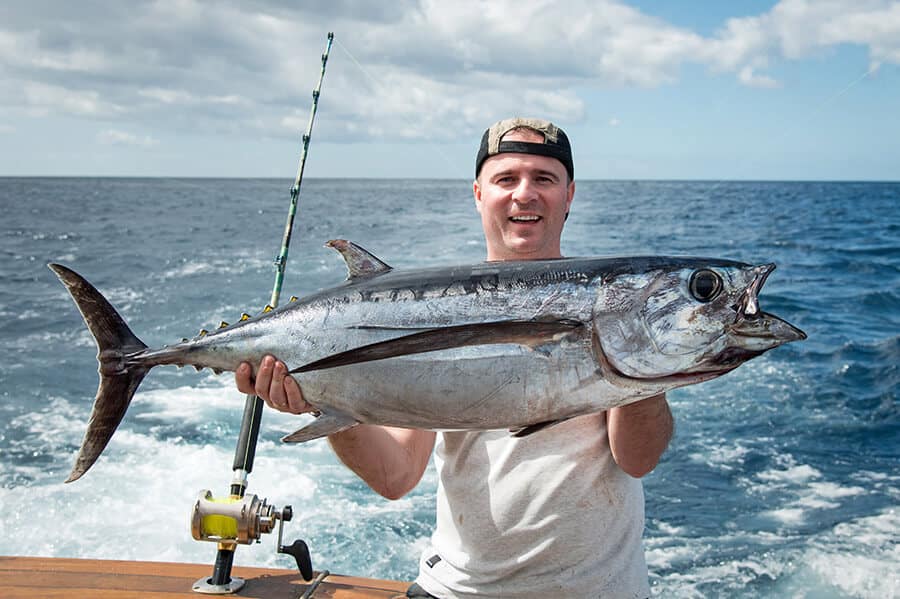
Prices for a fishing trip start at $150 per person. This includes fishing tackle, bait, boat rental for 8 hours, a guide, fuel, lunch and soft drinks
Snorkelling provides an opportunity to get acquainted with plant and animal life near the sea's surface. You do not need to take swimming lessons to snorkel: just fins, masks, and snorkel.
7 scenic places for snorkelling in the Caribbean Sea
Diving. Divers are attracted by the Mesoamerican Barrier Reef, a unique natural phenomenon that is included in the UNESCO World Heritage List. The barrier reef begins in the north of the Yucatan Peninsula, runs along the east coast of Central America and ends in the coastal waters of Honduras. The total length of the reef is 965 km.
The longest part of the reef, about 300 km, is called the Belize Barrier Reef. Divers from all over the world dream of diving into this complex system of picturesque caves and grottoes.
Seven marine reserves of the Belize Reef for divers
The Great Blue Hole was discovered by Jacques Yves Cousteau. Its funnel has a diameter of 305 meters and a depth of 120 meters. Only experienced divers with at least 24 dives are allowed to dive.
The Bacalar Chico National Park and Marine Reserve entered the UNESCO World Heritage List in 1996. Crocodiles and sea cows inhabit it. It takes 1.5 hours to reach the reserve by boat from San Pedro or one of the fishing villages of Belize, such as Sarteneja.
Sapodilla Cayes Marine Reserve covers an area of 125 km², or the size of a small town, along the southern part of the Barrier Reef. The angelfish, a yellow-blue fish, depicted on the banknotes of Belize, live on the reef.
Glover’s Reef Marine Reserve is named after two pirate brothers, John and Rodger Glover, located on a small island. Dolphins and manatees can be seen in the waters of the reef. Tourists describe walking through the reserve as a trip to a lost island, which looks like an ideal hideout for pirates.
The South Water Caye Marine Reserve is the second largest marine reserve in Belize. Its territory is divided into zones: a special place is allocated for frigate birds and brown boobies. In Pelican’s Pouch, visitors can observe corals, sea sponges and fish.
Half Moon Caye Natural Monument is a small coral island located near the Great Blue Hole. About 100 species of birds live on the island, and sea turtles live in the coastal waters and on the beaches. Entrance to the island costs about $50.
Laughing Bird Caye National Park is located on a coral island with about 70 species of corals, octopuses, moray eels and spotted rays.
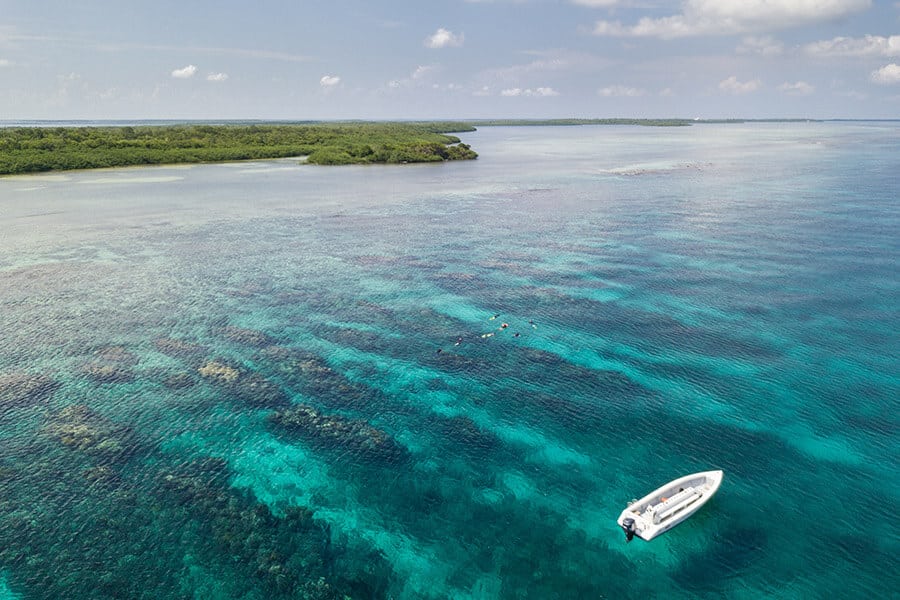
View of part of the Belize Barrier Reef, which is visited by about 130,00 tourists a year
Pirate treasures are another reason to go diving in the Caribbean. Pirates appeared in the Caribbean in the 17th century and gradually became the scourge of maritime trade throughout the world. They hid treasures on the islands, fought sea battles and sank ships. As a result, treasure hunters, including divers, travel to the Caribbean Islands from all over the world.
Interestingly, the Russian Empress Catherine II's initiative effectively ended piracy. At the time, pirates significantly damaged trade in the area, mainly due to the absence of a powerful local fleet to protect the trading vessels. Catherine II proposed that neutral countries agree to cooperate against piracy.
As a result of the agreement, the combined fleet gradually suppressed piracy on the high seas and set up an economic blockade of countries' ports that supported licensed piracy or privateering. This gradually reduced the threat of piracy to an insignificant level.
In the 21st century, excursions to old ships and places where pirates lived are popular among tourists. Animation companies arrange themed evenings where they recreate scenes from the life of pirates in the Caribbean.
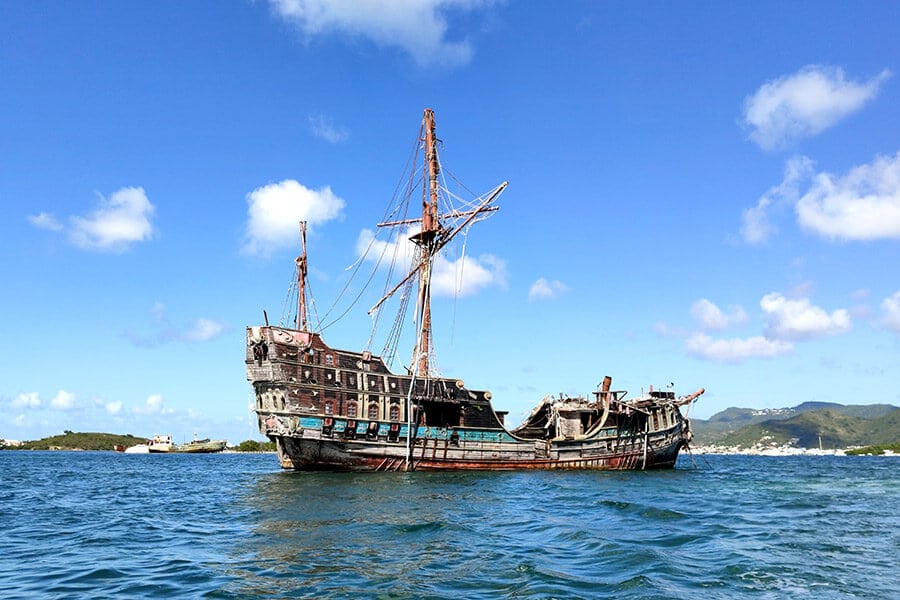
Restored pirate ship in Simpson Bay Lagoon, St Martin
Yachting. Each Caribbean state has ports where you can rent a yacht. You can find discussions of the best marinas and ports in the Caribbean on internet yachting forums.
Yachtsmen recommended these marinas on these forums for their equipment and quality of service:
-
Virgin Islands: East End;
-
British Virgin Islands: Road Town;
-
Guadeloupe: Pointe-à-Pitre;
-
Grenada: St George's;
-
Cuba: Cienfuegos;
-
Martinique: Le Marin;
-
St Vincent and the Grenadines: St George;
-
St Lucia: Rodney Bay.
To save on taxes when buying a yacht and maintaining it and to protect their privacy, wealthy people register a ship under the flag of the Caribbean state. However, foreigners cannot register yachts in the Caribbean countries in their name, but only through a legal entity.
Regattas. The region hosts about 20 international and local regattas every year. The next international race, Grenada Sailing Week, starts on January 30, 2022.
Top 7 regattas in the Caribbean Basin, according to Exploring Caribbean
When to visit the Caribbean
The most comfortable time to visit the Caribbean is from December to April when the rainy season begins. At this time, it is not hot on the islands, and when it does occasionally rain, the rain is pleasantly refreshing.
The air temperature in the Caribbean Basin rarely drops below +20°C during the year, and the average monthly water temperature in the Caribbean is about +27°C.

The table provides detailed average monthly data on the water and air temperature and rainfall.
The roughness of the sea varies from light to moderate and remains within three or four points on the scale used for navigation. The winds over the sea are northern and eastern, at up to 7 meters per second.
Average monthly weather indicators in the Caribbean Sea
Travelling to the Caribbean
There are direct flights from Europe, the United States, and South America.
Examples of approximate prices for flights to the Caribbean, January 2022
Visitors can also sail to the Caribbean Islands on cruise liners from Europe, the United States and South America. The routes vary, and the journey can take anywhere between one day to six months. Ticket prices start at $100 per night without meals as of January 2022.
During the pandemic, entry to countries in the Caribbean was restricted for tourists, depending on the epidemiological situation.
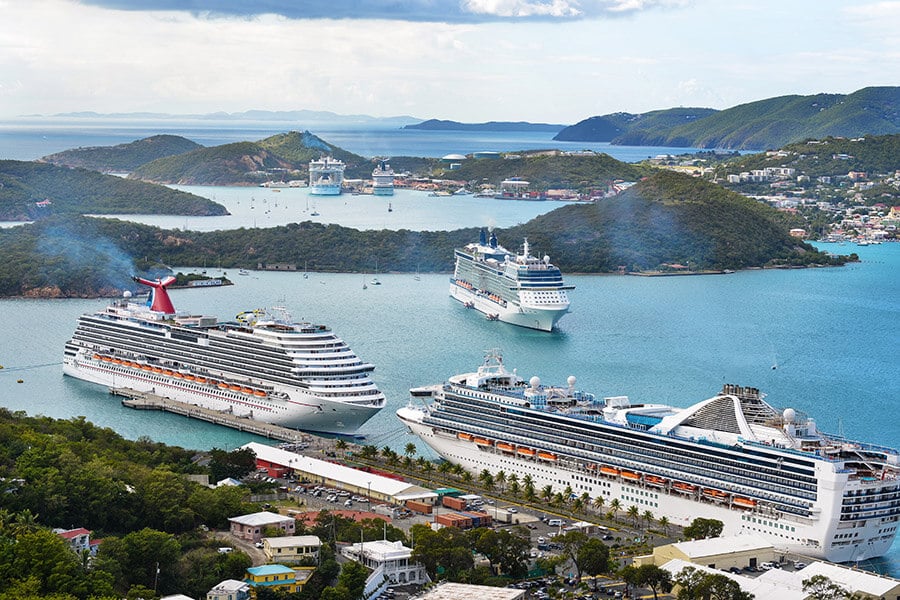
Cruise ships arriving at the Port of St. Thomas, U.S. Virgin Islands
How second citizenship helps you to take holidays in the Caribbean
It is easier for citizens of the Caribbean countries to take holidays in the Caribbean than for foreigners. There are various legal restrictions imposed on foreigners. For example, a foreigner cannot just buy or build a villa. First, the government has to issue a special licence allowing a foreigner to own land.
Yachtsmen can only register a yacht if they have Caribbean citizenship. Furthermore, the cost of registering a yacht and taxes on it in the Caribbean are about two-thirds of those in Europe.
If a wealthy person moves to the Caribbean with their family, their children can also enrol at leading universities. For example, the investor's children can study medicine at the prestigious University of St. George in Grenada. Their degree is also recognised in the US and the UK.
Studying at a university for international students is comparable to the cost of studying in the UK. However, the state pays 90% of the cost for Grenadian citizens.
Therefore, we advise wealthy people who want to live in the Caribbean for the long term to apply for second citizenship by investment in one of the Caribbean countries. Dual citizenship will offer them and their families benefits, make their lives more secure, and give them the freedom to travel visa-free to the Caribbean and throughout the world.
Citizenship in a Caribbean country can be obtained for an investment of $200,000 in 6—8 months. It is fast and relatively inexpensive: in comparison, to become a Maltese citizen, foreigners invest at least €690,000. The process takes 1 or 3 years, depending on the investment amount.
The fastest way to get Caribbean citizenship is by investment. Five Caribbean countries—Antigua and Barbuda, Grenada, St Lucia, Dominica, and St Kitts and Nevis—offer government-sponsored citizenship by investment programs. Wealthy individuals invest in the economy of one of these countries and receive second citizenship.
Immigrant Invest is a licensed agent for citizenship and residence by investment programs in the EU, the Caribbean, Asia, and the Middle East. Take advantage of our global 15-year expertise — schedule a meeting with our investment programs experts.

Compare the Caribbean and Vanuatu citizenship by investment programs
-
Master the residency process
-
Get expert tips and documents
-
Estimate costs accurately


















